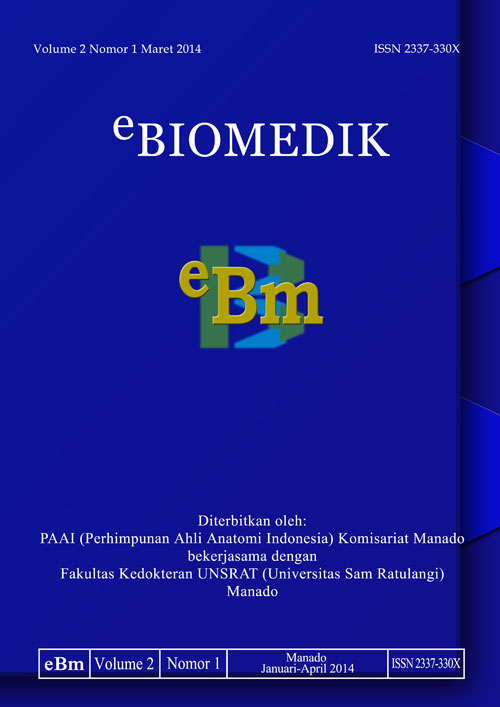PERBANDINGAN DETEKSI Plasmodium spp. ANTARA CARA PEMERIKSAAN MIKROSKOPIK SEDIAAN DARAH TIPIS DENGAN TEKNIK POLYMERASE CHAIN REACTION
DOI:
https://doi.org/10.35790/ebm.v2i1.3755Abstract
Abstract: Malaria disease is one of the priority of the health programs because it affects the Human Development Index, which result in icreased mortality among infants, toddlers, pregnant woman and adults. WHO noted that in 2010 there was 219 million cases of malaria with mortality rate of 660.0000 annually.Until now, the microscopic method who has many limitation is still the gold standard in malaria examination. On other side, Polymerase Chain Reaction which proved accurate as it can identify Plasmodium up to the stage of DNA is not yet use as routine examination of Malaria Disease. The purpose of this study was compare the sensitivity and specificity of detection Plasmodium spp. using the gold standard Microscopic examination (thin blood smear) with the Polymerase Chain Reaction (PCR) method. The design of this study is Diagnostic Test with a sample of 30 people whoose blood was drawn in malaria patients who come to the RSU Budi Mulia Bitung and RS Manembo-nembo since September 2013- Januari 2014. Blood taken made into a thin blood smear then extracted and proceeded to PCR. Then from the result of both test, diagnostic test applied to determine the level of sensitivity,spesificity,positif predictive value, and negatif predictive value. Results: The level of sensitivity of the PCR was 100%,specificity 60%, positif predictive value 83,33&, and negatif predictive value 100%.Conclusion: PCR is more accurate in determining the plasmodium species and produce fewer errors than the diagnosis of Microscopic examination thin blood smears.
Keywords: Microscopic Examination, Thin blood smear, Polymerase Chain Reaction (PCR), sensitivity, specificity
Â
Â
Abstrak: Malaria merupakan salah satu prioritas program kesehatan karena mempengaruhi Human Development Index yang mengakibatkan meningkatnya angka kematian pada bayi, balita, ibu hamil, dan orang-orang dewasa. WHO mencatat pada tahun 2010 terdapat 219 juta kasus malaria dengan angka kematian 660.000 setiap tahunnya. Sampai sekarang ini, metode mikroskopis yang memiliki banyak keterbatasan masih menjadi standar baku emas dalam pemeriksaan malaria. Dilain pihak Polymerase Chain Reaction yang terbukti akurat karena dapat mengidentifikasi plasmodium sampai pada tahap DNA belum dijadikan pemeriksaan rutin penyakit malaria.Tujuan : Penelitian ini membandingkan tingkat sensitivitas dan spesifisitas deteksi Plasmodium spp menggunakan pemeriksaan baku emas yaitu mikroskopik sediaan darah tipis dengan Polymerase Chain Reaction (PCR). Metode : Penelitian ini merupakan penelitian uji diagnostik dengan sampel sejumlah 30 orang yang darahnya diambil  pada pasien malaria yang datang ke RSU Budi Mulia dan RS Manembo-nembo sejak bulan September 2013 - Januari 2014. Darah yang diambil, dibuat menjadi hapusan darah tipis, kemudian diekstraksi dan di lanjutkan ke pemeriksaan PCR. Kemudian dari hasil kedua pemeriksaan, dilakukan uji diagnostik untuk mengetahui tingkat sensitivitas, spesifisitas, nilai duga positif dan nilai duga negatif. Hasil: Tingkat sensitivitas PCR sebesar 100%, spesifisitas sebesar 60%, nilai duga positif sebesar 83,33% dan nilai duga negatif sebesar 100%.Simpulan: PCR lebih akurat dalam menentukan spesies plasmodium dan lebih sedikit menghasilkan kesalahan diagnosis daripada pemeriksaan mikroskopik sediaan darah tipis.
Kata Kunci: Pemeriksaan Mikroskopis, Sediaan Darah Tipis,Polymerase Chain Reaction (PCR), Sensitivitas, Spesifisitas.





